Originally, yoga was introduced as an exercise practice to encourage the body to sit for longer increments of time during meditation.
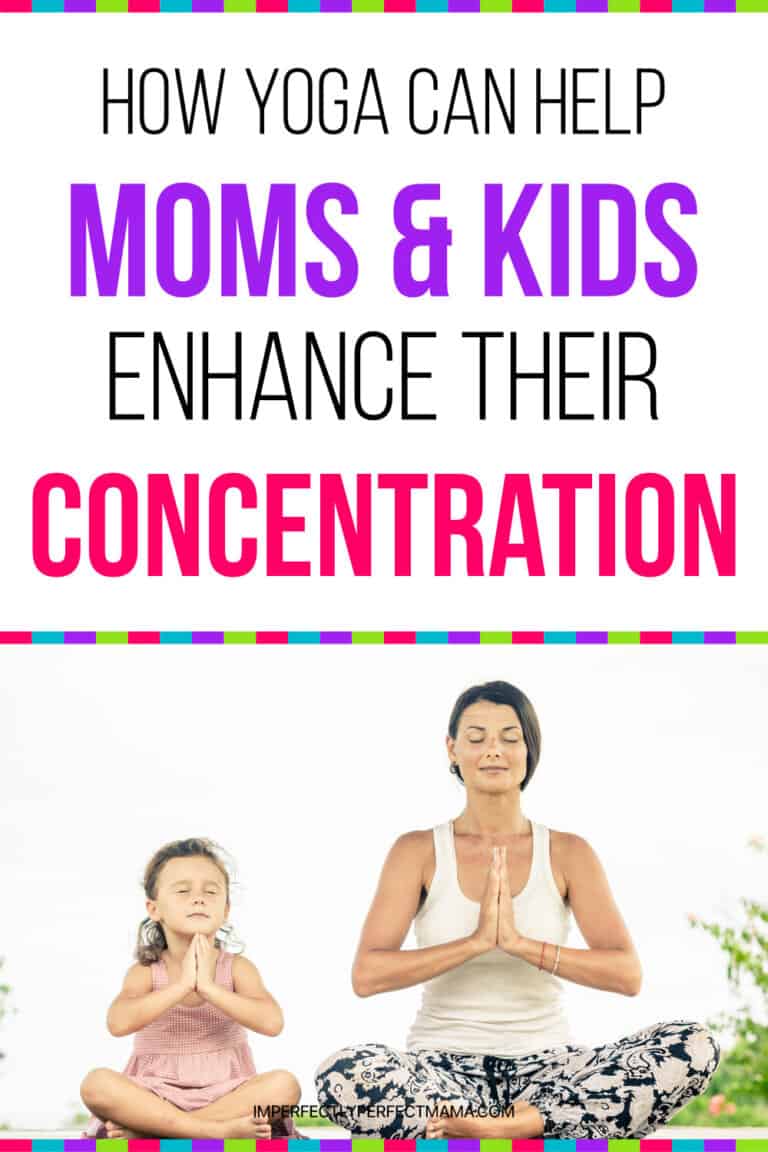
Yoga is an ancient Hindu and Buddhist practice linking physical movements (the yoga asana) with deep breathing and mental awareness.
Today, yoga utilizes numerous yoga sequences—a series of poses done in a certain chronological order —for improved physical, increased mental vibration, and concentration.
Plus, the best part about yoga is that any age group can reap its benefits.
Yogis of all ages gain a sense of peace, calm, and confidence through a consistent yoga practice.
Once you start teaching yoga to kids by age and your kids begin to feel and experience the health benefits of yoga, they’ll have an inner resource to call on when grown-ups aren’t around.
Self-soothing and self-awareness are important skills that will help kids enhance their concentration levels through all stages of life—even deep into adulthood.
In short, yoga can play a powerful role in nurturing a kind, active, confident, mindful, and empowered child.
The Five Basic Building Blocks of Yoga
Whether you and your children are beginners or advanced practitioners, these three building blocks of yoga will help you generate creative, restorative, and fun yoga sessions for adults as well as for kids.
The basis building blocks of yoga include breathing, meditation, yoga poses, sequences, and relaxation.
1. Breathe
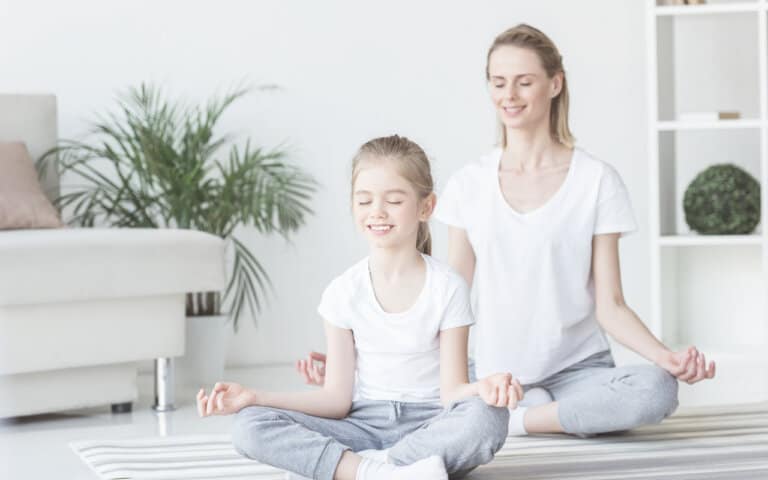
Yoga helps us build a habit of attention to the breath.
Building a connection to your breath is a vital and foundational practice of yoga.
Otherwise, you are simply moving your body around into funny shapes!
Many yoga traditions suggest breathing in and out is best done through the nose as you get into a pose or try to hold it.
It is not always appropriate for children (especially younger toddlers), but simply growing attuned to the breath and noticing it flow in and out during practice is enough to feel the benefits.
2. The Pose
Yoga poses allow us to be active in a way that builds strength, flexibility, and concentration and soothes the nervous system.
Some yoga poses may feel fun and easy to access, while others are more challenging.
I often hear new mothers say things like “I’m not flexible enough since postpartum, so I don’t do yoga” or “I can’t touch my toes, so I don’t do yoga.”
Actually, we have an ideal image of yoga practitioners in the media.
Thus, we believe that only super flexible people can perform challenging yoga poses. Well, fear not because yoga is for everyone!
If your kid has tight hamstrings, they can bend their knees as much as they’d like to reach a simpler version of a Forward Fold Pose.
There is no goal in yoga other than to be present with yourself and connect to what is true for you.
Every Pose will provide you with a new physical and mental adventure.
So, be open to trying something fun with your kids.
3. The Sequence
A yoga sequence is a series of dynamic yoga poses designed to guide the body through the practice.
Different yoga sequences can provide you various health benefits, like short or long, fast or slow, calming or energizing.
One of my yoga teachers often reminds his students that simple, repeatable yoga posture sequences have the most powerful and soothing effect on the body.
So, when you and your child discover a yoga sequence that works for you, allow it to become your go-to yoga routine.
You can also add some new poses to your sequence or mix up the order of poses at any time.
Remember, yoga works best when practiced frequently and honestly in a way that nourishes your mind and soul.
4. Meditate
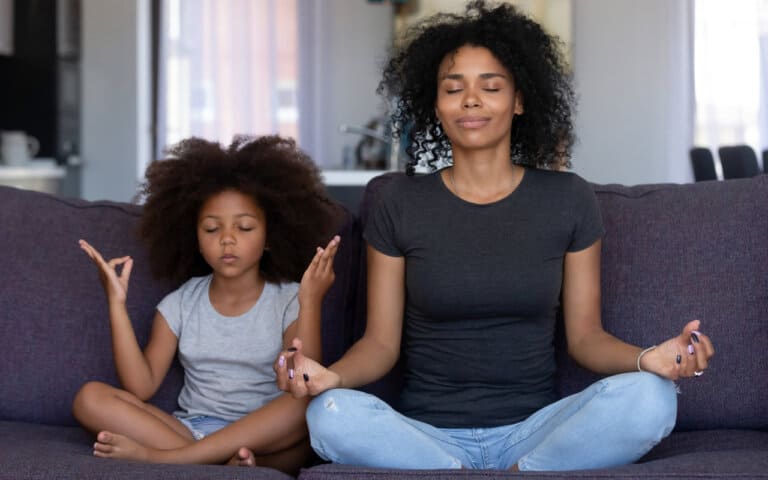
Meditation is a powerful practice offering a variety of ways to tune into your thoughts and feelings.
Especially for kids, this is a significant and unique experience because it’s not necessarily taught in schools.
Meditation can be wonderfully calming and therapeutic some days, and it may feel excruciating on others.
It can be challenging to slow down and sit still with so many distractions in today’s world.
However, encourage kids to keep trying even if they feel frustrated.
One simple but effective way to help kids notice the power of meditation is to ask them how they feel on a scale of 1 to 10 before and after the meditation.
5. Relax
In addition to movement and meditation, relaxation is the final most integral part of yoga.
Learning to unwind after yoga practice is crucial for adults and children.
In yoga, we learn to anchor into the breath and consciously rest our bodies.
This helps moms and kids release stress while enabling them to focus better on their work and studies.
7 Yoga Asanas for Moms & Kids to Enhance Concentration
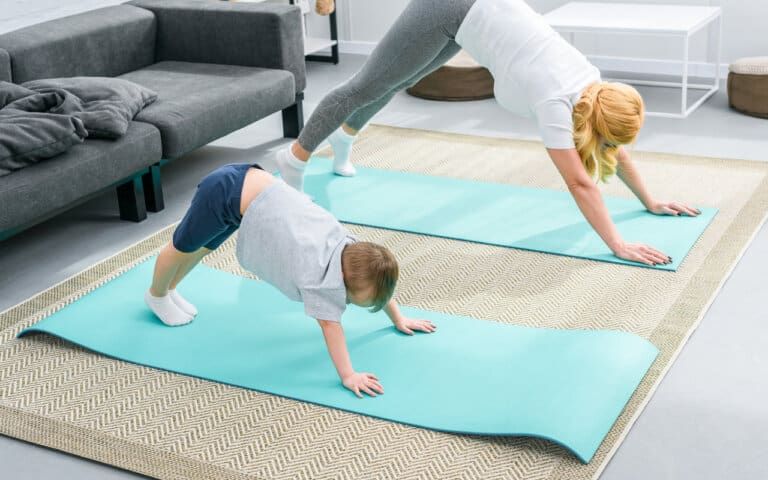
Now, all moms in the house, get ready! It’s time to start planning your family yoga time!
Before we get into the specific poses and sequences, keep the following things in mind as you build out your yoga sessions.
Yoga time with kids needs to offer a lot of variety—otherwise, little ones can quickly lose interest.
So, I included lots of options for the various building blocks of a dynamic yoga practice.
You’ll learn how to mix and match so your sessions best suit the needs of your family.
Many of the yoga activities energize and build strength while simultaneously calming the nervous system.
Other activities are designed for relaxation and stillness through visualization, breathing, or meditation.
During the practice, you may find that some kids are drawn to a slow, deeply therapeutic practice of yoga, and others enjoy a more active or athletic practice.
Take the time to figure out which approach best suits your family on any given day.
Now, get ready to breathe, move, play, and relax in your home or on the go as you make yoga a regular family activity.
1. The Mountain Pose
At first glance, the Mountain pose may look like standing, but it is so much more!
Help kids feel as strong as a mountain by emphasizing strong legs, spine, relaxed shoulders, and hands active by their sides.
The Mountain pose is the starting point for many yoga sequences and is a great pose to come back to if little ones get distracted during practice.
2. The Forward Fold
Forward Fold increases blood flow to the heart and head.
It also improves lower-body flexibility and provides a great release in the lower back.
This is a great pose to incorporate early on in your practice to get the blood flowing.
Encourage kids to notice how Forward Fold feels at the beginning of practice and later on when the muscles have warmed up some—chances are, they’ll find themselves bending even deeper toward the ground.
3. The Table Top
Table Top pose is a foundational resting pose we often use between poses. Be sure to keep your core engaged and neck long while in this Pose.
Encourage kids to make their back “as flat as a table” while in this position—you could even try balancing something light on their backs to make it more fun.
4. The Childs Pose
Child’s Pose is an essential resting pose in yoga. You can take the Pose anytime during a yoga session or a stressful moment in your day.
Resting the forehead on the ground with the head lower than the heart has a refreshing and calming effect.
You can remind kids that they loved this Pose when they were babies before even knowing what yoga was!
Encourage self-care in yourself and your little one by taking a break in Child’s Pose whenever you need to rest and regroup.
5. The Cat Pose
In Cat, we round the spine high and tall.
This stretches the back, shoulders, and neck.
Be sure to let your head hang heavy to take pressure off the neck. When you exhale into Cat, squeeze the belly in as far as it will go and round the spine simultaneously.
You can even say “squeeeezzze” to encourage everyone to exhale and squeeze the belly in.
6. The Cow Pose
Cow pose is a slight adjustment to Table Top and the counterbalance to Cat.
In Cow, we stretch the belly down toward the earth and open the heart up to the sky.
Encourage kids to look “up, up, up!” to get the best stretch through the neck and shoulders.
7. The Down Dog
Down Dog is a simple inversion and a fundamental building block for yoga sequences.
Young kids love this one because they can pretend to be a dog while trying out the Pose.
While Down Dog is simple, you can always continue to refine the position by pressing down with your fingers, sending your hips up higher, rotating your elbows in, and pressing your heels toward the mat.
Nearly the whole body is engaged during this Pose.
Performing any three of these yoga poses every day with your kids will help you both relax, rejuvenate, and concentrate better.
Make sure to breathe correctly, hold every Pose for at least 60 seconds, and repeat this for 3 to 4 more sets.
The Final Takeaway
Now, most mommies will stress over – “How to Structure Yoga Sessions with Kids?”
Structuring a yoga class for the entire family may seem daunting at first, but it can be a fun and rewarding experience with a little planning and persistence.
Here are the following ways to structure yoga class with kids,
- Keep the yoga session short. For young kids, start with 5 to 10 minutes of yoga practice and do not exceed 20 minutes in a day.
- Try to explain to kids why you’ve decided to try this out as an activity together. Say something like, “We’re going to try yoga this morning to have fun and get ready for our day!”
- Longer sessions can include a variety of activities or child-friendly games.
- Create a yoga theme every time you practice yoga with your children. Like, jungle yoga theme with animal poses like “cobra pose,” “lion laugh pose,” “cat pose,” etc.
- If your child resists meditation, try guiding them gently with your voice. Or make up a light fairy tale starring a favorite pet or toy.
Remember, the most important aspect of structuring a family yoga practice is to be present to your child’s needs and preferences. You can make kids sit still, but you can’t force them to meditate or do yoga.
Be creative, plan well, and make the yoga practice fun for your kids.

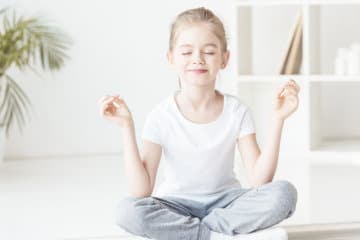


Leave a Reply